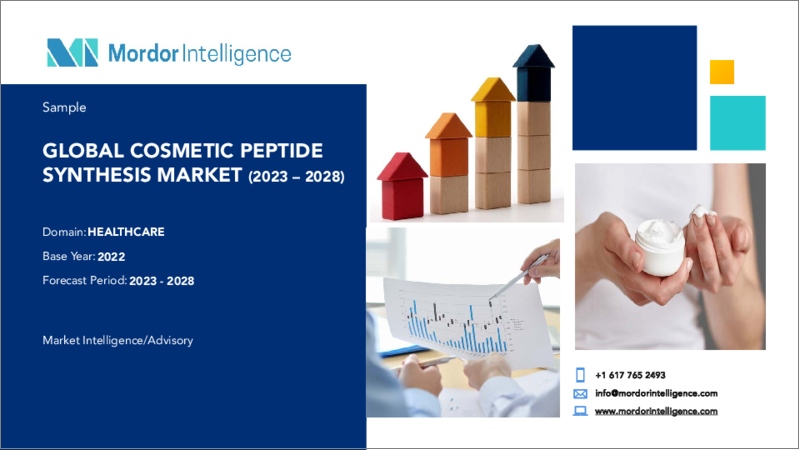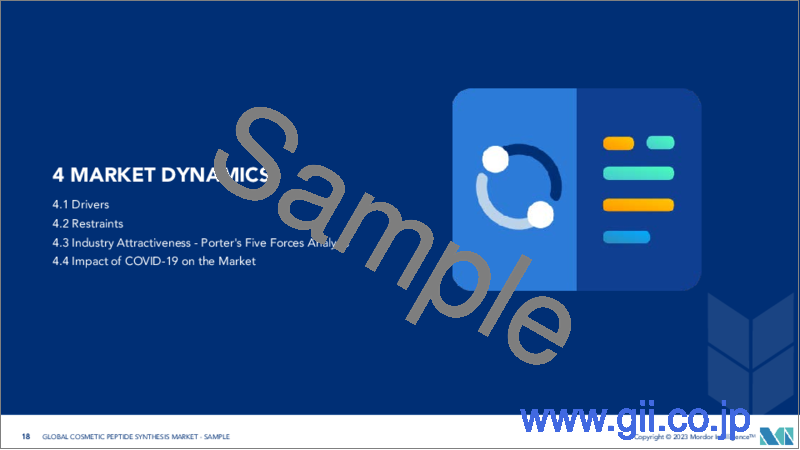|
|
市場調査レポート
商品コード
1190466
化粧品用ペプチド合成市場-成長、動向、予測(2023年~2028年)Cosmetic Peptide Synthesis Market- Growth, Trends, and Forecasts (2023 - 2028) |
||||||
|
● お客様のご希望に応じて、既存データの加工や未掲載情報(例:国別セグメント)の追加などの対応が可能です。 詳細はお問い合わせください。 |
|||||||
| 化粧品用ペプチド合成市場-成長、動向、予測(2023年~2028年) |
|
出版日: 2023年01月18日
発行: Mordor Intelligence
ページ情報: 英文 120 Pages
納期: 2~3営業日
|
- 全表示
- 概要
- 目次
化粧品用ペプチド合成市場は、2022-2027年の予測期間に5.5%のCAGRで推移すると予想されています。
パンデミックは、化粧品用ペプチド合成業界を含む化粧品業界に対して全体的にマイナスの影響を与えます。例えば、2021年10月に発表された調査研究「パンデミック時の美容。The Impact of COVID-19 on the Cosmetic Industry」は、化粧品の使用量に大きな差があると述べているが、COVID後の予測使用量では、目、唇、肌の化粧品の使用量はCOVID前の水準に戻るとされています。米国化粧品業界は、2020年に大幅な減少を予想していたにもかかわらず、COVID後の意図としては、使用量はCOVID前の結果に戻ると予測しています。スキンケアカテゴリは、COVID半ばでほとんど減少せず、COVID後は増加すると予想されます。スキンケア製品は、業界が変化するパンデミックを経ても持続可能であることから、新商品ラインとして導入することが強く推奨されます。同様に、2020年10月にInternational Journal of Eating Disordersに掲載された「Understanding impacts of the beauty industry shutdown during COVID-19」という別の論文では、SwinburneのCentre for Mental Health(CMH)の研究者が主導した調査により、COVID-19が始まってからほとんどの人が自分の容姿への投資時間が減少したと報告しているが、異形性の高い人は引き続き自分の容姿に対して自意識があると感じていると述べています。
目や皮膚の障害の増加などは、市場成長の重要な要因の一つです。カナダ緑内障研究協会によると、2021年にはカナダで約40万人が緑内障を患っています。同資料では、人口の高齢化とベビーブーム世代の高齢化が進む中、将来的に緑内障にかかる人が多くなるとされています。これは、化粧品用ペプチドの需要を増加させるでしょう。したがって、今後の市場の成長を増加させる。同様に、2021年のオーストラリア保健福祉研究所によると、皮膚のメラノーマの約166878件の新しいケースが診断されました。同ソークルは、男性9,869人、女性7,009人が診断されたと述べています。2019年の年齢標準化死亡率は、10万人あたり4.5人(男性6.6人、女性2.8人)でした。2021年の年齢標準化死亡率は10万人あたり4.0人(男性5.6人、女性2.6人)と推定されます。皮膚のメラノーマの死亡率は、加齢とともに増加することが予想されます。したがって、皮膚がんの増加は、化粧品用ペプチドの使用によって回避できる可能性があります。したがって、がんの有病率の増加は、今後の市場の成長を増加させると思われます。
化粧品ペプチドを採用するための重要な課題の1つは、人々はまだcosmticsが薬効を提供しないと信じていることである意識。例えば、2021年12月に医学の国立図書館に掲載された論文は、糖尿病性網膜症に苦しむ人々と継続的な目のスクリーニングのために行くとの間の直接の相関関係を証明する決定的な研究がないことを述べた。早期発見は、後眼部疾患に罹患した患者に治療を提供できる要因の1つであるが、患者が治療を開始するのが遅いため、認知度の不足が市場の成長を阻害します。しかし、認知度が低いため、患者が治療を開始するのが遅くなり、市場の成長が阻害される可能性があります。
化粧品用ペプチド合成の市場動向
予測期間中、アイケアセグメントが大きな市場シェアを占める見込み
目の負担の増大は、市場成長の重要な要因の1つです。例えば、世界保健機関の2021年10月の報告書によると、世界中の約22億人が近視または遠視の障害を持っており、そのうち約10億の視力障害の症例が予防できる、または予防できたことを示し、世界中の視力障害の症例の高い負担と治療の可能性は、研究市場の成長を推進している目に関連する疾患の治療薬の非常に高い需要が存在する理由であります。
緑内障の疫学」と題された2020年11月に発表された調査研究によると。The Past, Present, and Predictions for the Future」によると、緑内障は血管、遺伝、解剖学的、免疫学的要因の組み合わせによって発生し、不可逆的な失明を引き起こす可能性があり、白内障に次ぐ失明原因の第2位であることから、健康上の重大な懸念事項であるとされているとのことです。同調査によると、世界で約5,750万人が原発性開放隅角緑内障(POAG)に罹患していると推定されており、2040年には1億1,180万人に達すると予想され、これは非常に大きな増加であるため、有効な治療薬の需要も世界的に増加することが予想されます。治療薬の需要の高まりは、化粧品用ペプチドの消費を増加させ、将来の市場成長を高めるでしょう。
また、加齢も視力障害の新たな要因となっています。国連が発表した「World Population Ageing Highlight of 2020」によると、世界の老年人口(65歳以上)は2020年に7億2700万人で、2050年末には15億人に達すると予想されています。眼科疾患の中には加齢に関係するものがあり、その有病率は高齢化社会で最も高いことが確認されているため、世界の老年人口の増加は研究セグメントの成長に大きな影響を与えるでしょう。高齢化が進むと、より多くの化粧品用ペプチドを消費する必要があります。したがって、上記の要因により、市場は将来的に成長する可能性が高いです。
予測期間中は北米が市場を独占すると予想される
北米は、予測期間を通じて化粧品用ペプチド合成市場全体を支配すると予想されます。この優位性は、目や皮膚疾患の有病率の増加、官民組織による研究開発と投資の増加、啓発プログラムによるものです。
米国の製薬業界は長年にわたり新薬の創出をリードしており、米国研究製薬工業協会(PhRMA)の会員企業は常に最前線に立ち続けています。米国研究製薬工業協会2020年版によると、米国の製薬会社は2019年に研究開発におよそ830億米ドルを費やし、2010年の507億米ドルから増加しました。疾病管理予防センター(CDC)が発表したデータによると、2020年には約410万人のアメリカ人が糖尿病性網膜症に罹患し、約90万人のアメリカ人が視力障害のある網膜症に脅かされているとのことです。糖尿病性網膜症は、眼科疾患の代表的な疾患の一つです。有病率の増加は、巨大な人口における治療への需要を高め、同国の市場成長を後押しすることになるでしょう。
同国における皮膚疾患の増加は、市場成長の重要な要因となっています。例えば、2020年にカナダ皮膚科協会が発表したレポートによると、約8,000人がメラノーマ皮膚がんに苦しんでおり、そのうち約4,400人が男性、3,600人が女性であることが記載されています。メラノーマは現在、カナダで7番目に多いがんであり、カナダ人の間で罹患率が上昇している数少ないがんの一つです。2019年10月に発表された調査研究「A Collagen Supplement Improves Skin Hydration, Elasticity, Roughness, and Density」によると、「A Collagen Supplement Improves Skin Hydration, Elasticity, Roughness, and Density:Results of a Randomized, Placebo-Controlled, Blind Study」によると、プラセボ対照臨床試験により、肌の水分量、弾力性、密度を回復できる栄養素を用いて肌の老化に対処できることが確認されたと述べています。したがって、ペプチドを使用することで、通常加齢に伴って起こるコラーゲン産生の減少を遅らせることができることを示唆する研究です。
皮膚科学に対する認識も、市場成長の要因の一つです。例えば、2022年5月には「International Conference on Challenges in Dermatology Management in Pediatrics(ICCDMP)」(カナダ・モントリオール)と「International Conference on Forensic Pathology and Dermatology(ICFPD)」(カナダ・バンクーバー)が開催される予定です。同様に、6月、7月、8月、9月と多くの会議が開催され、2023年にも会議が開催される予定です。これらの学会では、皮膚疾患に関する問題点や治療法について議論されます。化粧品ペプチドは皮膚の治療において重要な役割を担っているため、学会数の増加に伴い、皮膚障害に対する意識が高まり、その障害に対する化粧品ペプチド関連製品の消費量も増加することが予想されます。そのため、市場規模は拡大します。
したがって、上記の要因は、予測期間中にこの地域の市場成長を促進し、化粧品用ペプチド合成の世界市場における傑出した市場シェアに貢献すると考えられます。
化粧品用ペプチド合成市場の競合分析
化粧品用ペプチド合成市場は、複数の大手企業が存在し、中程度の競争状態にあります。買収、合併、研究協力などさまざまな戦略をとって市場での地位を拡大している企業もあれば、市場シェアを維持するために新製品を投入している企業もあります。2019年5月、CEM株式会社は世界初の大規模な自動マイクロ波ペプチド合成装置「Liberty PRO」を発売しました。このシステムは、最大15リットルのサイズの反応容器を利用して1バッチあたり1kgの粗ペプチドを合成でき、比類のない純度、スピード、廃棄物の削減が市場の収益シェアを押し上げています。現在、収益面で業界を支配している主なプレイヤーは、AAPPTec、CSBio Company Inc.、Biotage AB、Bachem Holding AG、CEM Corporationの一部です。
その他の特典
- エクセル形式の市場予測(ME)シート
- アナリストによる3ヶ月間のサポート
目次
第1章 イントロダクション
- 調査の前提条件と市場の定義
- 調査対象範囲
第2章 調査手法
第3章 エグゼクティブサマリー
第4章 市場力学
- 市場概要
- 市場促進要因
- 眼・皮膚疾患の増加
- 研究開発の活発化
- 市場抑制要因
- 化粧品用ペプチドの承認に向けた厳しい規制
- ポーターのファイブフォース分析
- 新規参入業者の脅威
- 買い手/消費者の交渉力
- 供給企業の交渉力
- 代替品の脅威
- 競争企業間の敵対関係
第5章 市場セグメンテーション(金額ベース市場規模:百万米ドル)
- 技術別
- 固相
- 液相
- ハイブリッドおよびリコンビナント
- 用途別
- アンチエイジング
- アイケア
- 色素沈着防止
- 育毛
- エンドユーザー別
- 製薬・バイオテクノロジー企業
- 開発・製造受託機関(CDMO)
- 学術・研究機関
- 地域別
- 北米
- 米国
- カナダ
- メキシコ
- 欧州
- ドイツ
- 英国
- フランス
- イタリア
- スペイン
- その他の欧州地域
- アジア太平洋地域
- 中国
- 日本
- インド
- オーストラリア
- 韓国
- その他アジア太平洋地域
- 中東・アフリカ地域
- GCC
- 南アフリカ共和国
- その他の中東・アフリカ地域
- 南米地域
- ブラジル
- アルゼンチン
- その他の南米地域
- 北米
第6章 競合情勢
- 企業プロファイル
- AAPPTec
- Activotec
- Active Peptide
- Bachem Holding AG
- Bio Basic Inc
- Bio Synthesis
- CEM Corporation
- Creative Peptides
- CSBio Company Inc.
- GenScript
- Merck KGaA
- RS Synthesis, LLC
- vivitide
第7章 市場機会と今後の動向
The cosmetic peptide synthesis market is expected to register a CAGR of 5.5 % over the forecast period of 2022-2027.
The pandemic has an overall negative impact on the cosmetic industry including the cosmetic peptide synthesis industry. For instance, the research study published in October 2021, titled "Beauty During a Pandemic: The Impact of COVID-19 on the Cosmetic Industry" stated significant differences in cosmetic usage; however, post-COVID predicted usage indicates that cosmetic usage will revert back to pre-COVID levels for eye, lip, and skin cosmetics. Despite that the US Cosmetic Industry expected a significant decline in 2020, usage is predicted to return to pre-COVID results for post intentions. The skincare category had little decline mid-COVID and is expected to increase post-COVID. Implementing skincare products as a new product line is highly recommended due to its sustainability through an industry-changing pandemic. Similarly, another article published in October 2020 in the International Journal of Eating Disorders titled "Understanding impacts of the beauty industry shutdown during COVID-19" stated that the study led by researchers from Swinburne's Centre for Mental Health (CMH) has found that while most people reported spending less time investing in their appearance since COVID-19 began, individuals with high dysmorphic concern continued to feel self-conscious about their appearance.
Factors such as increasing disorders of eyes and skin are one of the key factors for the growth of the market. According to Glaucoma Research Society of Canada around 400,000 people were suffering from Glaucoma in Canada for the year 2021. According to the same source with increasingly ageing population and an aging baby boom generation, many more people will have glaucoma in the future. This would increase the demand for the cosmpetic peptides. Thus, increasing the growth of the market in the upcoming future. Similarly, according to the Australian Institute of Health and Welfare in 2021, around 16,6878 new cases of melanoma of the skin were diagnosed. The same soucre stated that 9,869 males and 7,009 females were diagnosed. In 2019, the age-standardised mortality rate was 4.5 deaths per 100,000 persons (6.6 for males and 2.8 for females). In 2021, it is estimated that the age-standardised mortality rate will be 4.0 deaths per 100,000 persons (5.6 for males and 2.6 for females). The mortality rate for melanoma of the skin is expected to increase with age. Hence, increasing skin cancer could be avioded by the usage of cosmetic peptides. Thus, increasing prevalence of cancer would increase the market growth in upcoming future.
Awareness is one of the key issue for adopting the cosmetic peptides are people still believes that cosmtics does not provide medicinal benifits. For instance, in December 2021 a paper published in National Library of Medicine stated that there is no conclusive study that proves direct correlation between people suffering from diabetic retinopathy and going for continuous eye screening. Early detection is one of the factors that could provide the treatment for the patients suffering from posterior segment eye disorders however lack of awareness would hinder the growth of the market as patient would start treatment at the later stages. Hence, due to above mentioned factors the market is likely to grow in the future.
Cosmetic Peptide Synthesis Market Trends
Eye Care Segment is Expected to Hold a Significant Market Share Over the Forecast Period
Increasing eye burden is one of the key factors for the growth of the market. For instance, according to the October 2021 report of the World Health Organization, about 2.2 billion people around the world have near or distance vision impairment, of which approximately 1 billion cases of vision impairment can be prevented or could have been prevented which shows the high burden of the cases of vision impairment around the world and possibility of treatment which is why there is a very high demand of the therapeutics for the diseases associated with eyes that are driving the growth of the studied market.
According to the research study published in November 2020, titled "Epidemiology of Glaucoma: The Past, Present, and Predictions for the Future", glaucoma occurs due to the combination of vascular, genetic, anatomical, and immune factors and is a significant health concern as it can cause irreversible blindness and is the second leading cause of blindness after cataracts. As per the same study, it is estimated that approximately 57.5 million people around the world are affected by the primary open-angle glaucoma (POAG) which is expected to reach 111.8 million by 2040, which is a very significant increase and thus, the demand for effective therapeutics is also expected to increase around the world. Increasing therapuetics demands would increase the consumption of cosmetic peptides which will increase the market growth in the future.
Ageing is also an additional factor for eye sight related disorder. According to the World Population Ageing Highlight of 2020 published by the United Nations, the global geriatric population (people of age 65 years or more) was 727 million in 2020 and is expected to reach 1.5 billion by the end of the 2050. Thus, growing global geriatric population will have a significant impact on the growth of the studied segment as it is observed that some of the eye disorders are age related and their prevalence was found highest in the ageing population. Increasing ageing populaiton would require to consume higher amount of cosmetic peptides. Hence, due to above mentioned factors the market is likely to grow in the future.
North America is Expected to Dominate the Market Over the Forecast Period
North America is expected to dominate the overall cosmetic peptide synthesis market throughout the forecast period. The dominance is due to the growing prevalence of eye and skin disorders, and increasing R&D and investment via public and private organizations coupled with awareness programs.
The pharmaceutical sector in United States has long been a leader in the creation of new medications, and member businesses of the Pharmaceutical Research and Manufacturers of America (PhRMA) continue to remain at the forefront. According to the Pharmaceutical Research and Manufacturers of America 2020, pharmaceutical companies in United States spent roughly USD 83 billion on R&D in 2019, up from USD 50.7 billion in 2010. According to the data published by the Centers for Disease Control and Prevention (CDC) in 2020 around 4.1 million Americans are affected with diabetic retinopathy, and nearly 900,000 Americans are threatened with vision-damaging retinopathy. Diabetic retinopathy is one of the leading disorders of eye disorders. Increasing prevalence will increase the demand for treatment in huge population which will boost the growth of the market in the country.
Increasing number of skin disorders in the country is a key factor for the growth of the market. For instance, in 2020 a report published by Canadian Dermatology Association stated that around 8,000 people are suffering from Melanoma skin cancer our of which around 4,400 were men and 3,600 were women. Melanoma is now the 7th most common cancer in Canada and one of the few cancers with incidence rates on the rise among Canadians. According to the research study published in October 2019, titled "A Collagen Supplement Improves Skin Hydration, Elasticity, Roughness, and Density: Results of a Randomized, Placebo-Controlled, Blind Study" stated that placebo-controlled clinical trial confirmed that skin aging could be addressed using nutrients that are able to restore skin hydration, elasticity, and density. Hence, the research suggests that the use of peptides can slow down the decline in collagen production that usually occurs with ageing.
Awareness of dermatology is another factor in the growth of the market. For instance, in May 2022 there are two conferences namely, the "International Conference on Challenges in Dermatology Management in Pediatrics (ICCDMP)" (Montreal, Canada) and the "International Conference on Forensic Pathology and Dermatology (ICFPD)" (Vancouver, Canada) are expected to held. Similarly, there are many conferences in June, July, August, and September followed by conferences in 2023 are expected to held. These conferences would discuss the issues and treatment reated to dermatological disorders. As cosmetics peptides play a crucial role in the treatment of skins, as the numebr of conferences increases the awarenss for skin disoder will increase along with the consumption of the cosmetic peptide related products for those disorders. Hence, this will increase the market growth.
Hence, the above mentioned factors are likely to fuel the market growth in this region across the forecast period, contributing to its outstanding market share in the global cosmetic peptide synthesis market
Cosmetic Peptide Synthesis Market Competitive Analysis
The cosmetic peptide synthesis market is moderately competitive, with several major players. Some companies are expanding their market position by adopting various strategies, such as acquisitions, mergers, and research collaborations, while others are introducing new products to maintain their market share. In May 2019, CEM Corporation launched Liberty PRO, the world's first-ever large-scale automated microwave peptide synthesizer. The system can synthesize 1 kg of crude peptide per batch utilizing a reaction vessel, with sizes up to 15 liters with unmatched purity, speed, and waste reduction fueling the market revenue share. A few of the major players currently dominating the industry in terms of revenue are AAPPTec, CSBio Company Inc., Biotage AB, Bachem Holding AG, and CEM Corporation.
Additional Benefits:
- The market estimate (ME) sheet in Excel format
- 3 months of analyst support
TABLE OF CONTENTS
1 INTRODUCTION
- 1.1 Study Assumptions and Market Definition
- 1.2 Scope of the Study
2 RESEARCH METHODOLOGY
3 EXECUTIVE SUMMARY
4 MARKET DYNAMICS
- 4.1 Market Overview
- 4.2 Market Drivers
- 4.2.1 Increasing Prevalence of Eye and Skin Disorders
- 4.2.2 Increasing Research and Development Activities
- 4.3 Market Restraints
- 4.3.1 Stringent Regulation for Approval of Cosmetic Peptide
- 4.4 Porter's Five Force Analysis
- 4.4.1 Threat of New Entrants
- 4.4.2 Bargaining Power of Buyers/Consumers
- 4.4.3 Bargaining Power of Suppliers
- 4.4.4 Threat of Substitute Products
- 4.4.5 Intensity of Competitive Rivalry
5 MARKET SEGMENTATION (Market Size by Value - USD million)
- 5.1 By Technology
- 5.1.1 Solid-Phase
- 5.1.2 Liquid-Phase
- 5.1.3 Hybrid and Recombinant
- 5.2 By Application
- 5.2.1 Anti Ageing
- 5.2.2 Eye Care
- 5.2.3 Anti Pigmentation
- 5.2.4 Hair Growth
- 5.3 By End User
- 5.3.1 Pharmaceutical and Biotechnology Companies
- 5.3.2 Contract Development and Manufacturing Organization (CDMO)
- 5.3.3 Academic and Research Institutes
- 5.4 Geography
- 5.4.1 North America
- 5.4.1.1 United States
- 5.4.1.2 Canada
- 5.4.1.3 Mexico
- 5.4.2 Europe
- 5.4.2.1 Germany
- 5.4.2.2 United Kingdom
- 5.4.2.3 France
- 5.4.2.4 Italy
- 5.4.2.5 Spain
- 5.4.2.6 Rest of Europe
- 5.4.3 Asia-Pacific
- 5.4.3.1 China
- 5.4.3.2 Japan
- 5.4.3.3 India
- 5.4.3.4 Australia
- 5.4.3.5 South Korea
- 5.4.3.6 Rest of Asia-Pacific
- 5.4.4 Middle-East and Africa
- 5.4.4.1 GCC
- 5.4.4.2 South Africa
- 5.4.4.3 Rest of Middle-East and Africa
- 5.4.5 South America
- 5.4.5.1 Brazil
- 5.4.5.2 Argentina
- 5.4.5.3 Rest of South America
- 5.4.1 North America
6 COMPETITIVE LANDSCAPE
- 6.1 Company Profiles
- 6.1.1 AAPPTec
- 6.1.2 Activotec
- 6.1.3 Active Peptide
- 6.1.4 Bachem Holding AG
- 6.1.5 Bio Basic Inc
- 6.1.6 Bio Synthesis
- 6.1.7 CEM Corporation
- 6.1.8 Creative Peptides
- 6.1.9 CSBio Company Inc.
- 6.1.10 GenScript
- 6.1.11 Merck KGaA
- 6.1.12 RS Synthesis, LLC
- 6.1.13 vivitide




